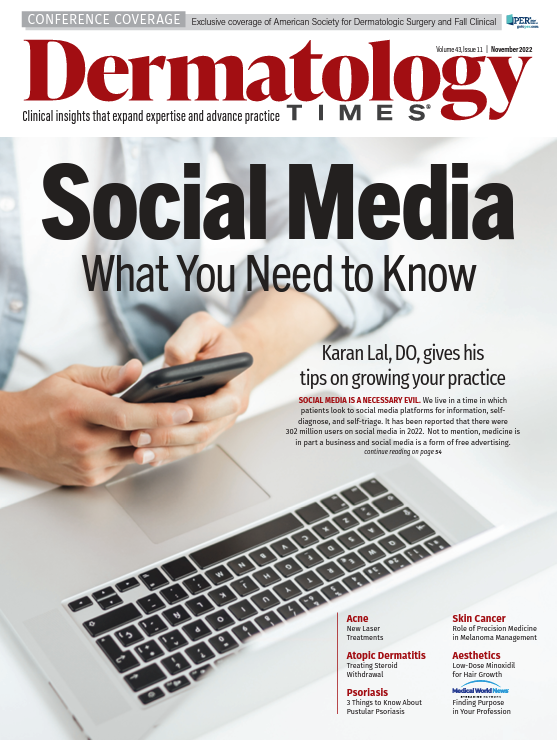- Case-Based Roundtable
- General Dermatology
- Eczema
- Chronic Hand Eczema
- Alopecia
- Aesthetics
- Vitiligo
- COVID-19
- Actinic Keratosis
- Precision Medicine and Biologics
- Rare Disease
- Wound Care
- Rosacea
- Psoriasis
- Psoriatic Arthritis
- Atopic Dermatitis
- Melasma
- NP and PA
- Skin Cancer
- Hidradenitis Suppurativa
- Drug Watch
- Pigmentary Disorders
- Acne
- Pediatric Dermatology
- Practice Management
- Prurigo Nodularis
- Buy-and-Bill
Publication
Article
Dermatology Times
Treating Skin Cancers in the Immunotherapy Era
At the 2022 Fall Clinical Dermatology Conference, a dermatologist shares results of using cemiplimab-rwlc (Libtayo) for basal and squamous cell carcinoma.
One of the first things Todd E. Schlesinger, MD, FAAD, director of the Dermatology and Laser Center of Charleston in South Carolina, noted in his opening remarks of his session on treatment for BCC and CSCC, sponsored by Sanofi Regenron Oncology, was, “whether locally advanced or advanced, you do not want to identify these conditions alone.” A multidisciplinary team is crucial every step of the way, he emphasized.
Schlesinger then reviewed 3 key points practitioners should note in dealing with these cancers: identify patients with locally advanced basal cell carcinoma (laBCC) or cutaneous squamous cell carcinoma (aCSCC) who are candidates for systemic therapy; highlight the importance of a multidisciplinary approach in the management of these patients; and review the clinical efficacy and safety data of a systemic therapy option for these conditions.
More than 5 million nonmelanoma skin cancer cases are diagnosed in the United States each year, more than any other type of cancer. If caught early enough, these cancers can be cured by surgery; however, more than 20,000 patients in this country progress to advanced BCC. And, not surprisingly, those with advanced BCC report QOL impairment, including daily activities, emotional well-being, social and leisure activities, and general function.
Schlesinger discussed the major factors associated with an increased risk of progression to advanced stages of the disease, including location (cheeks, forehead, head, neck, hands, feet, etc.); size (greater than 20 mm on trunk and extremities; greater than 40 mm on any body location); pathology (aggressive growth pattern, perineural involvement, rapid growth rate, poorly defined borders, etc); history (recurrent disease, and site of prior radiotherapy); and immunosuppression and neurological symptoms.
For those patients with advanced disease who are no longer candidates for curative surgery or radiation, systemic therapy may be recommended. “However,” warned Schlesinger, many things should be taken into account, from tumor characteristics to patient characteristics, such as age, comorbidities, performance status, as well as treatment history.”
Here is where multidisciplinary teams are crucial, as they help evaluate treatment options for patients who either discontinue or are inappropriate for hedgehog inhibitor treatment (HHI). Cemiplimab-rwlc (Libtayo) was approved in 2021 for the treatment of advanced BCC for those who could not be treated with HHI, and a few years earlier, approved for laCSCC and mCSCC who were not candidates for surgery or radiation. By blocking the PD-1 pathway, cemiplimab-rwlc helps to restore the antitumor T-cell response. Out of a 46% objective response rate, 31% of patients had a reduction in tumor sizer, and 15% had a disappearance of tumors.
The treatment, an IV infusion, is given for 30 minutes every 3 weeks. “It is also important to note that you can slow, withhold, or withdraw the infusion, but you cannot reduce dosage,” said Schlesinger. Possible adverse effects need to be carefully monitored, notes Schlesinger, and can include fatigue, musculoskeletal pain, diarrhea, nausea, and constipation, among other effects. Additionally, cemiplimab-rwlc can cause more serious adverse effects, among them immune-mediated pneumonitis or colitis, which is why consistent monitoring is key.
Reference
Schlesinger TE. Co-managing patients with locally advanced basal cell carcinoma (laBCC) and advanced cutaneous squamous cell carcinoma (aCSCC) in the immunotherapy era. 2022 Fall Clinical Dermatology Conference. October 22, 2022. Las Vegas, Nevada.






